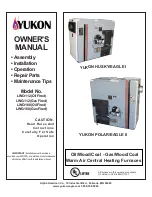
IM 685-1
17
Generally a valve will he found that has an effect, and very
little adjustment will cause a reduction in the minimum rate
manifold pressure. Reduce the pressure adjustment of that
dominant valve by slowly rotating the adjuster CCW until
the manifold pressure no longer drops in response to that
adjuster movement. If the manifold pressure is still high after
that first adjustment, another valve may have become the
dominant valve and that may also have to be isolated and
adjusted to get down to the specified minimum rate manifold
pressure. After making this type of adjustment it is necessary
to recheck the maximum firing rate manifold pressure and
perhaps readjust it, making very small but equal adjuster
movements on each valve.
Combustion Testing
Proper start-up and maintenance requires periodic combus-
tion tests and the systematic recording of those test results
for future reference. Before making combustion air adjust-
ments, check for proper input rate.
Verify Input Rate
To determine the input rate it is necessary to know the BTU
per cubic foot of gas being used. If this is not known, contact
the gas supplier. Check input rate by timing the gas meter
dial with all other appliances and their pilot lights off.
To verify the input rate using the gas meter, use a stopwatch
and time one revolution of the dial. Calculate the input with
the following formula:
MBH Input= A x B x 3.6
C
Where: A = BTU/cu. ft. of gas
Typical: Natural gas= 1000, LP gas=2500
B = Cu. ft. per revolution of meter dial
C = Seconds required for 1 revolution of meter dial
Check CO
2
, CO & Stack Temperature
Flue gas samples are to be taken from inside one of the sec-
ondary tubes. If the sample is taken from the flue box rather
than the tube, the sample will be diluted with outside air and
lower readings will result. If flue gas temperature is to be
measured, this must be done in the flue box, not in the tube.
The temperature gradient within the tubes would cause high
readings near the center of the tube and low readings near
the edge. Temperatures should be measured within the flue
box where a good mix will be present. The flue box includes
two 5/16" holes for test purposes. One hole lines up with the
end of a secondary tube for taking flue gas samples. The
other hole, through the side of the flue box, is for thermome-
ter insertion.
If the CO
2
and/or CO readings are not within the range indi-
cated, see "Troubleshooting Guide," Section 4.1 and 4.2.
Figure 12a Figure 12b
Typical Readings:
CO
2
9
½
to 10
½
percent at maximum rate
4 to 7 percent at minimum rate
CO
.005 percent (50 PPM) or less
Cleaning Heat Exchangers
Models 032 thru 200 (see Figure 13)
1. Remove the flue box front wrap (1)
and the rear inspec-
tion cover (3).
2. Remove and clean the turbulator (2)‚ from each tube and
clean the flue box.
3. Clean each tube with a 2
½
" round flue brush.
4. Remove the brushings and if required clean the combustion
chamber and header through the rear inspection door port.
Figure 13. Models 032 thru 200 Heat Exchanger
5. Reinstall the inspection door (3). Snug the screws but do
not overtighten and crush the insulation.
6. Reinstall a turbulator (2)
in each tube approximately
flush with the tube ends. The end of the turbulators are
formed such that the end will bind within the tube end
and lock the turbulator in place.
7. Reinstall flue box front wrap (1)
.
300º
400º
500º
600º
Temperature Gradient
within Tube
Co
2
Sample
Measure
Temperature
3
2
1
2 1/2 Round Flue Brush With 7 Foot Handle
Summary of Contents for SuperMod IM-685-1
Page 27: ...IM 685 1 27 Notes ...










































